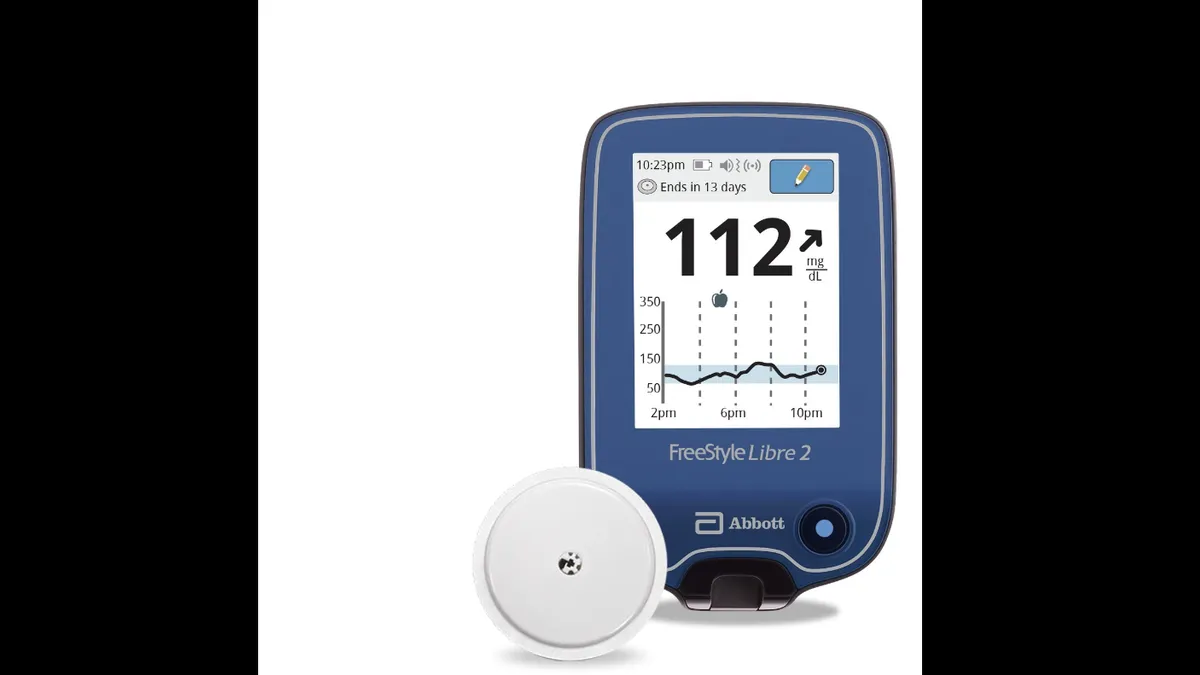Dive Brief:
- More than 50% of Type 2 diabetes patients in the U.S. could be using a continuous glucose monitor to measure their blood sugar levels in the next three years, according to new research from Jefferies based on their survey of roughly 50 endocrinologists and general practitioners. That's up from 30% of the U.S. Type 2 patients now using the technology.
- Insulin pump adoption among Type 2 patients in the U.S. is likely to reach more than 35% in the same time frame, nearly double the level in use today, the analysts also predict.
- Jefferies pegs the Type 2 market opportunity as nearly six times the size of the Type 1 market and expect Abbott Laboratories, Dexcom and Insulet to benefit the most from greater use of diabetes technologies. The report comes as companies in the space eye the Type 2 market as their next big opportunity.
Dive Insight:
Use of continuous glucose monitors and insulin pumps has been steadily expanding in recent years, helping to insulate diabetes device makers when the COVID-19 pandemic slowed sales across medtech markets in 2020. CGM company Dexcom and insulin pump providers Insulet and Tandem Diabetes Care added users and saw revenues grow last year and in the first half of this year.
Jefferies noted Abbott added about 750,000 FreeStyle Libre CGM users through the first half of this year, about equal to the company's total prior year estimate.
"This acceleration in our view signals that (outside the U.S.) countries, where about 90% of the world's TI/TII patients reside, are ready for greater adoption," the analysts said.
Doctors see the combination of CGM and insulin pump therapy as facilitating the best outcomes for Type 2 patients, as measured by hemoglobin A1c levels and time in optimal blood sugar range, according to Jefferies' survey.
Driven by wider adoption of CGMs and insulin pumps among Type 2 insulin intensive users, the worldwide market for continuous glucose monitoring devices can approach $21 billion and the insulin pump market can reach $7.5 billion by 2030, up from $17 billion and $5.6 billion, respectively, the Jefferies analysts predicted.
The forecast takes into account 1.6 million U.S. Type 1 patients, 2.5 million U.S. Type 2 insulin intensive patients, and 6.8 million total worldwide Type 2 insulin intensive patients, based on data from sources including the American Diabetes Association, Centers for Disease Control and Prevention, JDRF, and private and public companies, according to Jefferies.
Current CGM and insulin pump penetration is about 30% in the U.S. Type 1 market and 10% to 15% across the global Type 2 market, according to the report.
The analysts wrote that updated market projections include expectations for the percentage of Type 2 insulin intensive patients globally who use CGM technology to approach 45% by 2030 and Type 2 insulin intensive patients who are pump users to approach 20%.
Earlier this year, analysts at SVB Leerink raised their outlook for CGM patient use, projecting it to climb by 38% in 2021 and 29% in 2022, based on the firm's survey of endocrinologists and nurse practitioners. SVB Leerink also boosted its forecast for patient adoption of insulin pumps, projecting growth of about 21% in 2021 and 17% in 2022.
Diabetes tech still faces access issues that could hinder future adoption.
Patients have complained the technology is too expensive, especially for certain patients with Type 2 diabetes who may not have to manage their health as intensely as those with Type 1. Groups like the American Diabetes Association have also highlighted that patients still struggle to get coverage from private insurance and government programs like Medicare and Medicaid for CGMs and insulin pumps.
Jefferies analysts addressed this in their report, noting that the top reasons for stopping use of CGMs are cost and coverage, not the performance of devices.
A recent coverage change by the Centers for Medicare and Medicaid Services is expected to improve patient access to CGMs. The rule change, which took effect in July, eliminated a requirement for patients to perform frequent self-monitoring blood glucose tests as a prerequisite for initiating CGM use.











